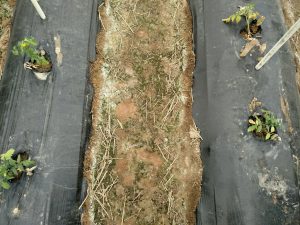I visited a few high tunnels around the state recently and used a hand-held soil electrical conductivity (EC) meter to test soil salinity levels inside of the structures. Although the hand-held EC meter may not give ratings as accurate as a soil test lab could provide, I had comparative ratings from several farms. Interestingly, by talking to growers, I found tomatoes grown in the high tunnels that have relatively high EC ratings seem to suffer more problems in the past season. In most cases, the unhealthy plants have been taken out of the tunnels by the time I visited (in early August). In one situation, the farmer reported flower abortion and a lot of blossom end rot. In another situation, the farmer described a widespread leaf spot symptom that was not a disease. He followed the recommendation based on plant tissue analysis, but the problem was not solved. In the third situation, tomato plants were still growing in the tunnel, but the plants were stunted and they were suffering from several pest problems. Although these problems may be not directly caused by high soil salinity, it is likely that the high salt levels in the soils facilitate the development of these problems. Since excessive fertilizers applied inside high tunnel/greenhouse can not be washed away by natural rains, high salinity is more likely become a problem inside these structures.
Effects of salinity on plant growth
Salinity reduces water availability for plant use, inducing water stress, which could cause stunted plant growth and other plant physiological issues. Another effect of high salinity on plant growth is when the excessive amount of salt enters the plant, it disturbs the nutrient balance and injures plant leaf cells.
Salinity problem may be overlooked on established tomato plants
Salinity problems normally can be detected if the level was in an extremely high range that injures or kills the newly planted seedlings. Earlier this season, we saw a greenhouse with tomatoes that did not develop any new roots after having been planted for a month (Figure 1). In this situation, the soil salinity level turned out to be very high. Salinity problems may be overlooked, however, when tomato plants have been established. Partly because other issues such as disease, insect or nutritional disorders may accompany the less healthy plants at this stage.

Figure 1. Stunted growth of tomato plants due to salt damage.
Soil test and data interpretation
If growers suspect the soils inside the high tunnel/greenhouse have high salinity, soil samples should be sent to soil labs for the salinity test. Most soil test labs provide service for basic soil salinity test. However, this service is not always included in the soil test packages. Growers need to be sure to select the test package that includes salinity test.
Correctly interpreting the results are also very important. Information about soil salinity tolerant levels of different crops is widely available, however, the information is developed from the saturated paste test that mimic soil water contents of the field condition. It is not always practical for soil test labs to conduct the test with saturated paste. Some labs may use 1:2 or 1:1 soil-to-water ratio for measuring electrical conductivity. It is very important for growers to know the method the lab used, and interpret the numbers accordingly. Interpretations of the EC values from soil extracts of 1:2 soil-to-water ratio and the saturated paste can be found in the tables below. These tables were adapted from the University of Georgia Extension ‘Soil Salinity, Testing, data interpretation and recommendations’.
Interpretation of electrical conductivity (mmhos/cm) data from soil extracts (1:2 soil-to-water ratio).
| Electrical Conductivity | Rating | Interpretation |
| 0-0.15 | Very low | Plants may be starved of nutrients. |
| 0.15-0.50 | Low | Plant may be starved of nutrients if soil lacks organic matter. Satisfactory if soil is high in organic matter. |
| 0.51-1.25 | Medium | Okay range for established plants. |
| 1.26 – 1.75 | High | Okay for most established plants. Too high for seedlings or cuttings. |
| 1.76 – 2.00 | Very high | Plants usually stunted or chlorotic. |
| more than 2.00 | Excessively high | Plants severely dwarfed; seedlings frequently killed. |
Interpretation of electrical conductivity (mmhos/cm) data from saturated paste extract.
| Electrical Conductivity (mmhos/cm) | Rating | Interpretation |
| 0 – 2 | Low | Very little chance of injury on all plants. |
| 2 – 4 | Moderate | Sensitive plants and seedlings of others may show injury. |
| 4 – 8 | High | Most non-salt tolerant plants will show injury; salt-sensitive plants will show severe injury. |
| 8 – 16 | Excessive | Salt-tolerant plants will grow; most others show sever injury. |
| more than 16 | Very Excessive | Very few plants will tolerate and grow. |